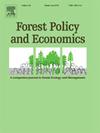Social determinants of Chilean forestry workers: A challenge for sustainable industry development
IF 4
2区 农林科学
Q1 ECONOMICS
引用次数: 0
Abstract
Objective
This study aims to identify the social determinants (SD) that influence employment in Chile’'s forestry sector. This study contributes to the existing body of knowledge by examining the interaction between various social determinants and the likelihood of individuals working in the forestry sector.
Methodology
To achieve this objective, data from the 2022 National Socioeconomic Characterization Survey, was used. 7700 people were included in this study. SDs were categorized into five groups according to the ESG criteria for social perspective: diversity; wage gap; employment benefits; workplace safety; and social programs. A probit model was used to determine average marginal effects. The model classified 92.7 % of the data accurately.
Results
Individuals most likely to work in the forestry sector are predominantly male, with lower educational levels, aged between 35 and 65, under fixed-term contracts, belonging to the lowest income quintiles, without economic or food incentives, facing health and nutrition issues due to lack of funds, and lacking access to communication or the Internet.
Conclusion
Workers in the forestry industry exhibit high social vulnerability, far from the social determinants established in ESG standards.
Value
This study of the Chilean forestry industry highlights the social dimension of ESG based on secondary data, differing from those published by companies. Studies of this type contribute to generating greater transparency and trust among stakeholders, thus promoting the formulation of policies and business strategies that help improve employment conditions in the forestry sector within the context of persistent inequalities.
智利林业工人的社会决定因素:可持续产业发展的挑战
本研究旨在确定影响智利林业部门就业的社会决定因素(SD)。这项研究通过考察各种社会决定因素与个人在林业部门工作的可能性之间的相互作用,对现有的知识体系作出了贡献。
本文章由计算机程序翻译,如有差异,请以英文原文为准。
求助全文
约1分钟内获得全文
求助全文
来源期刊

Forest Policy and Economics
农林科学-林学
CiteScore
9.00
自引率
7.50%
发文量
148
审稿时长
21.9 weeks
期刊介绍:
Forest Policy and Economics is a leading scientific journal that publishes peer-reviewed policy and economics research relating to forests, forested landscapes, forest-related industries, and other forest-relevant land uses. It also welcomes contributions from other social sciences and humanities perspectives that make clear theoretical, conceptual and methodological contributions to the existing state-of-the-art literature on forests and related land use systems. These disciplines include, but are not limited to, sociology, anthropology, human geography, history, jurisprudence, planning, development studies, and psychology research on forests. Forest Policy and Economics is global in scope and publishes multiple article types of high scientific standard. Acceptance for publication is subject to a double-blind peer-review process.
 求助内容:
求助内容: 应助结果提醒方式:
应助结果提醒方式:


